Legends
home
From a desert, from the driest continent, from this land at the opposite end of the globe ...
... as remote as could be in the hockey world ...
... came one of the world’s oldest winter sports trophies.
A cool tradition, a dream of champions, and a story we owe it to our children to tell.
Legends of Australian Ice.
[ ICE HOCKEY ] The First Lady of Australian Ice Hockey
Nan Irving (1911 - >1944)
![]() My fiance and I had patched up our quarrel, and we laid storm to Paris together. I gave skating exhibitions in England and diving displays in Paris. Paris likes long, lanky people. Modistes and dress designers began to rave over my figure, and I was frequently offered their most expensive and elaborate creations merely on condition that I appeared at the Lido, in the Champs Elysees, or in the popular cabarets. I owned a weird collection or mongrel dogs, one to match the colour of each of my frocks, and these became the horror of my fiance and intimate friends and the joy of my more lenient admirers. Always I had one of the bedraggled little horrors with me. I had also a Russian wolfhound, which cost me 8,000 good francs, and when on one occasion the aristocrat took exception to the presence of one of my plebion little pets in a fashionable cabaret, an afternoon tea dance that was in progress turned into a riot. You know, it was a hectic time I had in those months. I did many things that were perhaps indiscreet, but then I just can't help doing these things.
Nan Irving, Adelaide, January 1930 [1]
My fiance and I had patched up our quarrel, and we laid storm to Paris together. I gave skating exhibitions in England and diving displays in Paris. Paris likes long, lanky people. Modistes and dress designers began to rave over my figure, and I was frequently offered their most expensive and elaborate creations merely on condition that I appeared at the Lido, in the Champs Elysees, or in the popular cabarets. I owned a weird collection or mongrel dogs, one to match the colour of each of my frocks, and these became the horror of my fiance and intimate friends and the joy of my more lenient admirers. Always I had one of the bedraggled little horrors with me. I had also a Russian wolfhound, which cost me 8,000 good francs, and when on one occasion the aristocrat took exception to the presence of one of my plebion little pets in a fashionable cabaret, an afternoon tea dance that was in progress turned into a riot. You know, it was a hectic time I had in those months. I did many things that were perhaps indiscreet, but then I just can't help doing these things.
Nan Irving, Adelaide, January 1930 [1]
![]() Artistes and sculptors made me attractive offers to sit for them, but my fiance had warned me to be wary of them, so I declined most of their offers. I did sit for Garbell though. He has a great reputation in Europe. His first picture of me he called 'nan.' It became quite famous and was hung in two galleries. He painted several other portraits of me then in various guises, and they were known as the Nan series. They are selling for quite large sums now.
Nan Irving, Adelaide, January 1930 [1]
Artistes and sculptors made me attractive offers to sit for them, but my fiance had warned me to be wary of them, so I declined most of their offers. I did sit for Garbell though. He has a great reputation in Europe. His first picture of me he called 'nan.' It became quite famous and was hung in two galleries. He painted several other portraits of me then in various guises, and they were known as the Nan series. They are selling for quite large sums now.
Nan Irving, Adelaide, January 1930 [1]
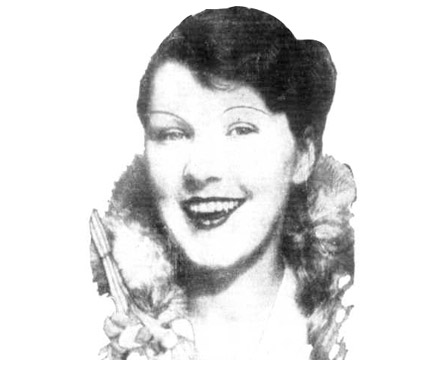
Nan Irving, 1929 [5]
SHE IS STANDING ON THE HIGH SPRINGBOARD of the Hotel Provençal at Juan-les-Pins, doing nought that he could see, just imparting order to all God's heavenly bodies. He listens to the sound of planets feeding on her ultimate fate, his thoughts suspended there in hers, shards against the sky, still reflecting on the surface she now pierces undisturbed. She is dancing on his chest, she does not let him sleep, and her thirst for danger could evaporate the deep. Flickering cinematic on his drawn eyelids. Aquaplaning the wake of a racing boat, motoring the wet sand of a rogue tide, skating a frozen lake, skiing a mogul. She will never close her eyes, she will never decline a dare, she makes him dream when he's awake, and laugh at all his cares.
The 23 year-old French-Hungarian nobleman didn't care why the most beautiful and daring debutante in all Europe was romancing him, and not one of the dozens, hundreds, of others whose eyes were fixated on the lithesome luminance now emerging from the glittering iridescence of the diving pool. It only mattered that she was. Like the old Hungarian title he did not use. Like the villa on the Cote d'Azur and the silk-making. Like the wealth he spent freely, the popularity he enjoyed amid the younger set of Parisian glitterati. Like all of this, it only mattered that it was, and in time he could teach her his countenance and reserve. She would soon weary of the high life, her heart would come to rest, and lie at last kitten-curled in his.
The beaches right along the length of the Cote d'Azur, the French Riveria, are not straight, rather cut with small inlets, and made of fine golden sand. But it was the pine wood groves that distinguished Juan-les-Pins, and led to its transformation into the crowded summer resort that became the playground of the rich and famous. The category-5 whirlwind known as Nan Irving had just turned 18 and, although she had been touring Europe now for perhaps 8 months, she was on this occasion returning to Paris after a quick trip to England to see the Schneider Cup. Eluding her chaperone, she pointed the Bugatti back down to the Riviera to meet her fiance, Marcel Robert Jalla. The great adventure that was Nan, was much like the great adventure of Juan itself.
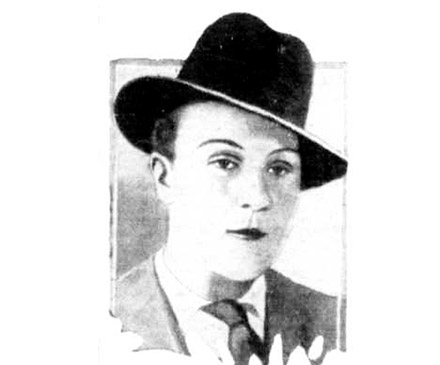
Marcel Robert Jalla, 1930 [5]
Deserted during the hot summers months, Juan was reborn soon after the old casino by the sea had been transformed into one of the most beautiful and busiest casinos of the Cote d'Azur, welcoming high society and the intellectual elite: Scott Fitzgerald, Charlie Chaplin, Marlene Dietrich, John Dos Passos, Picasso. To explain this strange analogy with the girl who was perhaps the first lady of Australian ice hockey, I shall have to return you to the streets of the distant land where Nan was born and, more precisely, to the Victorian cottage at No 62 Tivoli Rd, just off Toorak Road in South Yarra, an affluent inner-city suburb of Melbourne.
The Hobart couple who moved into No 62 had married a few months after the owner had been killed in the grey obscurity of a thick fog which overhung the Richmond station one morning in 1910. He was found among the crushed heaps of passengers of the telescoped carriages of two trains that collided there. The newly-weds were Harold Houlston Faulconer, a 21 year-old motor mechanic born to Scottish parents in Glasgow, and his wife, Jessie Babington, the 17 year-old daughter of John Babington and Mary Allan of Hobart. [3, 4]
Nan Irving was born Veata Irving Faulconer on September 7th 1911 at that same address, [5, 6] but her parents had a violent quarrel and separated some months later. [6] Nan grew-up with an absent father, a battler who paid half his wages in maintenance of both his estranged wife and Nan, while they moved on to eventually live in Albany Road, Toorak, one of the premier residential addresses in Australia. Or so it seemed. Nan herself attended St Catherine's School, and became a well-known Melbourne society girl.
Excelling at sport, she joined the West St Kilda Life Saving Club at St Kilda Beach, from where she developed into a wonderful swimmer and a daring and graceful diver. Like John Goodall's cousin, Mrs Simon Fraser, or Billy Clegg to friends, she was also well-known in the Portsea set. Located across Port Phillip from Melbourne, the resort town of Portsea is still synonymous with wealth and privilege. In fact, today the 3944 postcode is the nation's most affluent, immortalized in the James Reyne song, Hoochie Coochie Fiorucci Mama performed by the band, Australian Crawl. The Packard cornering on 2 wheels whenever Nan raced to the beach was a familiar sight in the late-1920s, and the beach roads were the course over which she laid the foundations of her subsequent motoring prowess.
It was at Portsea that Nan learnt to aquaplane, much like today's wakeboarders, but at a time when the sport of water skiing had only just been invented in the USA, where it was to remain in relative obscurity for quite some time to come. A central figure in the Portsea smart set, Nan and her exploits helped define the resort's reputation as "the Lido of Victorian beaches". They endured long after she was gone, and among the more memorable was the sun-drenched morning she arrived on Portsea pier in a bathing suit amid a great bustle of Melbourne society girls. "The speed-boat lying 200-metres off the pier is going to be mine, and at once," she informed the assembly and, clamping a roll of bank-notes in her mouth, she dived into the water. It was Nan who drove the boat at top speed to the pier, where a young Geoff Singleton alighted. Nan peeled off four £100 notes and calmly handed them to him. Owners of craft at Portsea and Sorrento went in fear and trembling for the rest of the holidays, aghast at the things Nan did with and to that boat.
In her darkest moments, Nan thought her girl friends were more interested in her car than her. She got along more easily with men but she was a team player, all the same, one of the best field hockey players in Victoria it is said, having played national and international field hockey in 1924, at the age of 13. [7] She had learnt to skate from a young age in Melbourne and probably London, Switzerland and elsewhere. Like an uncorked bottle of Dom Pérignon, the bubbling persona made her a popular favourite among the notables at Melbourne Glaciarium during the roaring twenties, and it was only natural she should join the Victorian Ladies Ice Hockey Club comprised mostly of Melbourne society girls.
The girl on the left wing for Victoria in the 1925 Gower Cup was Nan at the age of 14. Her interstate rivals included the captain-keeper Annie Ford, a spectacular sportswoman, a former lawn tennis and rowing champion of New South Wales, who represented her state on dozens of occasions. Nan and Edna Bostock were reportedly the best Victorian players in the 1928 Gower Cup. Some of the Victorian Ladies' IHC made their way to Switzerland and the first true Winter Olympics that year; Nan, Lucy Stogdale, Marea Lucas, their keeper, Dina Callaway, and others. The prominent sydney skaters, Charles Maclurcan and Jack Brown, also toured Europe at that time and attended the Games.
The Australian paparazzi were wrong to say Nan's mother sent her to a Swiss finishing school. She was meant to go to school in Paris, but got off at Toulon and went on to London, forcing her mother's hand and, through a firm of London bankers, an arranged chaperone. Not surprisingly, the chaperone also liked a good time, all expenses paid, and the pair met up with a friend and went off to Paris where Nan first met Marcel Robert Jalla at a large dinner party. From there, in the balmy summer of 1929, they followed the extravagant lifestyles filling the beaches of Antibes and Juan-les-Pins with youth and glamour, fast cars, sloe gin and jazz.
Their frequent appearances together in public, free spending and lavish entertaining attracted a lot of attention in both gay Paris and further south. Cap d'Antibes and Juan were to inspire Francis-Scott Fitzgerald's most famous novel, Tender is the Night, and also his Tales of the Jazz Age. The whole place was really an American Story and presiding over it all from May 1927 was the perfectly positioned and luxurious, Hotel Provençal. At various times Charlie Chaplin, Winston Churchill and Ernest Hemingway propped up the hotel's bar, an inspiration for Tender is the Night. Its summer rhythm was created by visitors just like Nan, who was chosen as Queen of the Sea on her return.
The High Diving Championship of the South of France that year was mostly contested by men with a snowball's chance in Hell. Nan won. She signed contracts she hadn't read with numerous companies filming there to play the role of a diving beauty. But she didn't. The real diva was too busy having the time of her life, spending heavily on entertaining, frocks, fast cars and gambling. Coco Chanel and Marilyn Monroe are said to have lounged on the expansive terrace of Nan's hotel and it was the direction in which that was inexorably headed that led to the quarrel with Jalla, her fiance.
That in turn was the reason Nan had bundled clothes into her Bugatti and sped off on a whirlwind tour of the south of France, Spain, Switzerland and Germany, before deciding to patch it up. A little later she returned to England's brand new Richmond rink to "carry all before her in the skating contest". [8] But it was her dishonoured cheques at the expiration of the £10,000 she spent in 6 months (about $700,000), that led her back to mother and, turning full circle, the discovery of her fiance that perhaps led mother to cable instructions to a solicitor in the French capital to deliver her back home to Melbourne.
On her arrival in Fremantle, out gushed Nan's story in all its naivety and slightly exaggerated glory. She finished by explaining she had not wanted to return home (although mother had nothing to do with it). She feigned illness (she was ill). She hatched a plan to elope, missed her birth on the Majola, got caught, got locked-up in separate cells. She convinced the Chief of Police not to leave her alone all night and, against all regulations, her fiance was sent for, and a little all-night party ensued, with an official in attendance. She was whisked-off to Scotland Yard next morning (for 2 minutes to collect a telegram), under the care of the British Consul in Paris and his wife, the only ones at the dock to see her off (who were personal friends and who had not detained her). "I've had a perfectly marvelous time. I shocked Paris, but I entertained them, and I think they will always have a soft spot in their hearts for their little Nan Irving." [8]
By the time news of Jalla sailing through Fremantle broke about 3 weeks later, the paparazzi in every state were already whipped into a bloody, frothing frenzy. Nan pointed the green and grey Stutz Eight at Queen's Pier in Adelaide, and floored it. She drove 500 miles incognito through the night, averaging 55 to 60 miles an hour, and only occasionally braking the powerful, heavy 8-cylinder into 360-degree spins to keep herself alert. Nan was safely ensconced with her lover in an Adelaide hotel the next night. The morning after, she smiled wickedly at the clambering press, in the same breath she told them she hated them. She denied she went to a ball on the ship Cormorin clad only in a shawl. She said she went as Tondeleyo, dressed in a grass skirt, and she hoped she and her fiance could marry in Melbourne and return to Paris.
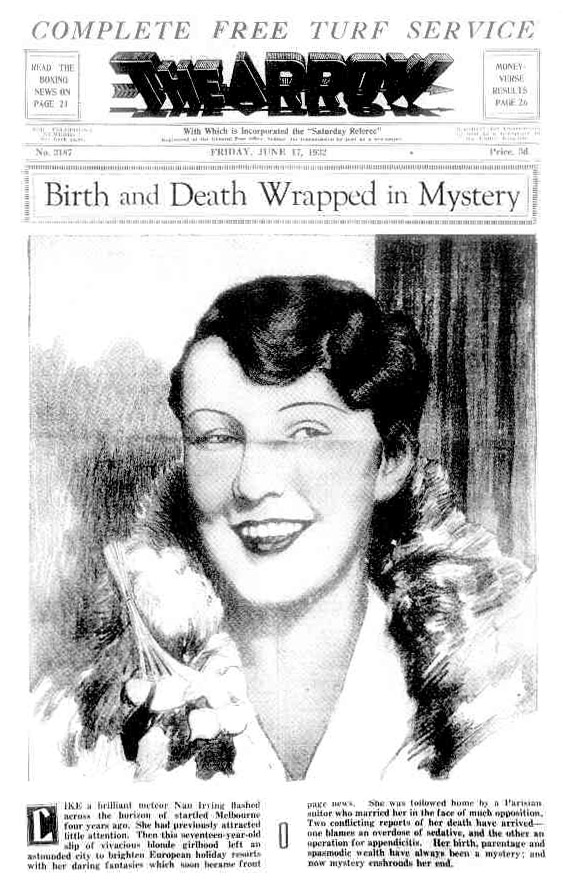
Nan Irving, Cover of the Arrow newspaper, Sydney, June 1932. [13]
The couple traveled back to Melbourne overland and stayed with Nan's mother in her Collins Street apartment. They were married that April in the city registrar's office. Both skated with Nan's teammates at Melbourne Glaciarium, where Jalla appeared equally accomplished. Who knows how it might have gone if Nan's father had not recognised his daughter in a West Australian newspaper, if he had not gone to Melbourne to see her that August. But he did. He had not seen Nan since he returned from war, when she was only 7 years-old, and this time she told him through pursed lips she did not know him, nor anything about him at all. [5] His six-foot-two bronzed frame was now at one with the Australian outback, not the city. His attempt to talk to Jalla was met with snobbery, and so he hit him in the mouth instead, a fop on the city pavement, Paris-end, of course. They scurried away, and all three soon disappeared from their Collins Street address.
Nan's father claimed he had been driven from the marital home by his wife's false accusations of womanising. It is unlikely he even suspected she was independently wealthy, prior to reading about his daughter's international adventure. Nan's mother had even issued a warrant for his arrest for non-compliance with the maintenance order when he moved to Sydney at the end of 1912, to work as the private chauffeur of the well-known Sydney politician and MHR, Willie Kelly. He said his wife continued to draw the payments throughout his war service, which meant he had helped support his daughter at least until she was 7 years-old. And there it could have remained, largely concealed beneath a thinly veiled witchery, but for the solitary miscalculation that today reveals Samuel John Claye.
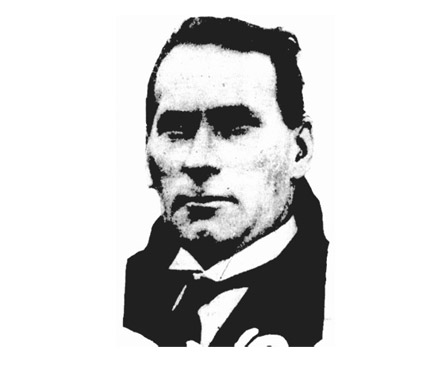
Harold Houlston Faulconer, Nan's father, 1930. [5]
Although Claye once boarded at Wesley College and Caulfield Grammar, he lived with his mother in South Yarra in 1914, when he first met Nan's mother. They shared a common interest in motor cycles and rode together from Melbourne to Sydney in early-1914, Jessie in the news as the first woman to make the trip on a motor cycle. Nan's mother knew Claye was entitled to a large inheritance under the will of his grandfather, Samuel John Claye, when he turned 21 in October 1916. She issued a warrant for his arrest in May 1914 for persistent annoyance and threatening to kill her because she resented his attentions. [9] He left home about July 1915. In October, unknown to his mother, he unlawfully married a sister of Nan's mother, Amelia Florence Babington, while still a 20 year-old minor. However, he was living with Nan's mother as man and wife.
Claye's mother took Nan's mother to court for detaining her son. The case was heard in his last days as a minor, just before he received his fortune. Nan's mother was 23 at the time. She told the court she did not receive an income from her own father's estate until she had turned 20 or 21, shortly after the separation. [4] Her father had died in October 1914. Justice Hood concluded she possessed an amazing amount of early immorality and had induced Claye, of weak intellect, to leave his mother and become very hostile towards her. [10] The judge was disgusted by the "filfth" in the letters he had sent her. Claye could not be found, and his mother lost her case against Nan's mother for lack of evidence. The judge pointed the police to the unlawful marriage of a minor.
The fortune was inherited by Claye, but his whereabouts remains a mystery to this day. Family histories record his death variously in the years 1915 to 1917. Sydney's Arrow newspaper once said, "'Smith's' stories of Nan's antecedents and escapades are said to have so shocked Nan's Aunt that she immediately died. Her body has never been found. However, Nan inherited a legacy from the Aunt." [14] The aunt died in Hobart on May 23rd 1917, married to a man named Ray Lewis. She was buried at Cornelian Bay cemetery at the age of 21. By 1919, when Nan was eight, her mother was still in her twenties and the proprietor of the Duke of Devonshire Hotel at 46 St Kilda Rd in St Kilda.
The Ritz Bar in liberated Paris, just inside the hotel's Rue Cambon entrance on the left, was as Victorian in 1944 as it is today. The red-velvet armchairs and bar furnishings, a marble fireplace and historic portraits have not changed. The extravagant concoctions of Frank Meier, the head barman there in those days, had largely gained the Ritz its reputation for glamorous cocktail parties. The woman standing there in the black dress and turban by Callot Soers wore silk stockings and beautiful shoes. Although haggard, her figure was excellent, and she looked exceedingly dashing, even at the Ritz, as you would expect from the city's house of traditionally dignified fashions.
Daily Mirror correspondent, Elizabeth Riddell, [12] asked if she wanted a message sent to Australia, but the woman replied with a marked French accent: "No, I don't want to have anything to do with Australia. I was a great scandal there. Everyone used to talk about Nan Irving and her mother. I'm never going back." Riddell had worked on the Sydney Truth in the late 1920s, won a Walkley Award for a series of articles on the brewing industry, then moved to England in 1935 to work for the Daily Express, and later the Daily Mirror in New York, London and Europe during World War II.
Jacques Desbaines de Roquefeuil spoke to her in the street when he noticed the Australia flash on her shoulder, and arranged for her to meet his wife next day. Madame de Roquefeuil told her she had divorced Jalla some time ago, but didn't tell her mother. She was still a marquise, although her husband did not use the title, between a count and a duke, that had been in the family for 1,100 years. Nan had left France at the outbreak of war in 1939, vaguely intending to return to Australia, but was stranded in South Africa without money. She claimed to have re-entered France without a passport or other papers, and drove an ambulance at the front line at some stage of the war.
"France is going to be communist, but it couldn't be worse than Australia, where everyone is paid too much," continued Nan in conversation with Riddell. "I remember my mother hiring a governess for me, and the governess arriving at our house in an Isotta Fraschini car. Workers in Australia burned down our house once. "Nan's husband drove a runabout while she drove a Rolls Royce, although both cars were jacked-up during the occupation. They confessed to being terrified of the FFI, the French resistance fighters, who had arrested and released them three times since liberation. In their company, Riddell met wealthy men who had experienced theft and damage to their houses while under suspicion of being collaborators. They showed them blackmarket restaurants with bars stocked with whiskey and gin which were virtually unattainable anywhere else. They claimed France would soon have a revolution. [11]
The French Resistance in Paris rose against the Germans just two months before Riddell met Nan. Eisenhower initially wanted to bypass the city to pursue other targets but de Gaulle insisted it should be taken immediately. Hitler's stated intention was to destroy it, and its citizens were going hungry. The men and women of the Résistance came from all economic levels and political leanings of French society. It played a significant role in the war but it was also politically and morally important as an inspiring example countering a threat to the very existence of French nationhood. The actions of the Résistance stood in marked contrast to the collaboration of the regime based at Vichy, which was reduced to a puppet government by Germany.
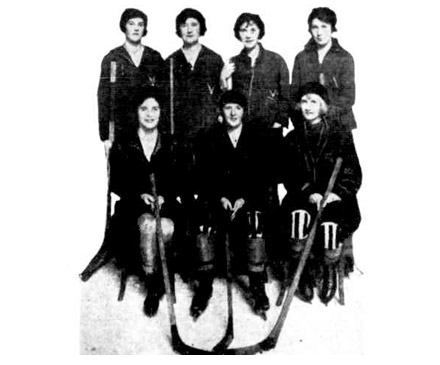
Victorian Ladies Ice Hockey Team, 1925. Nan is third from left in back row. [13]
Nan lived through the horror of war in a modern apartment with beautiful appointments in the suburb of Neuilly-sur-Seine, just beyond Bois de Boulogne. She told Riddell they were supported by her husband's mother and they now got petrol for their cars from some Americans, along with a paper entitling them to use a car. Riddell described her as the "vivacious and caustic-tongued Nan Irving-Faulkner, formerly of Melbourne," pointedly reminding her readers, "Nan had tried to give the wrong name to the registrar when she married Jalla in Melbourne at the age of 18 and little was heard of her from then on, although her prowess as a champion skater, skier and ice hockeyist for Victoria is still referred to. The legend that as an adolescent she carried huge sums in her purse and kept thousands in her dressing-table drawer has never been denied." [11]
It is very unlikely Nan's father Harry ever saw his daughter again. He died at the age of 58 in Darwin Australia on June 17th, 1947. In 1948, a 28 year-old French girl named Gillette Roquefeuil passed through Melbourne on her way home to Paris from Wellington, New Zealand, where she had been teaching languages. This was not Nan, but she was a Roquefeuil who drove an ambulance on the frontline for the French Free Forces, and was awarded the Croix de Guerre. [15] The Roquefeuil family of the French province of Languedoc had indeed received a proven marquisate created by letters patent in 1658, but it had become extinct in 1814.
![]()
2-1930 | 7-1930 | 6-1932 | 8-1932 | 10-1944 |
Video (slideshow above). Hoochie Coochie Fiorucci Mama performed by James Reyne, Peter Sarstedt's "Where Do You Go To My Lovely", a travel video of Cote d'Azur, and a video of a 7-seater Stutz Eight motor car. The model Nan drove was a 1928 1-seater roadster, which are now extremely rare. This one found its way here from the UK. It is said Nan bought two the same year she bought Singleton's launch.
Notes:
[1] The Register News-Pictorial Adelaide, SA Wednesday 29 January 1930 p 4
[2] The West Australian Perth, WA, 19 July 1910 p 5. Article: A Wandering Youth, His Mother Appeals to Court.
[3] Colonial Tasmanian Family Links, Family of John Babington born 1854 and Mary Allan
[4] The Register Adelaide SA 7 October 1916 p 10. Article: Suit for a Son, Wealthy Women and a Youth.
[5] Truth Sydney NSW 31 Aug 1930 p 10. Article: Big Blonde Bushman Claims he's Nan Irving's Father.
[6] Truth Sydney NSW 27 July 1930 p 14. Article: Nan Irving's Will Wore Down Her Mother's Fears.
[7] Advocate, Burnie, Tasmania, Mon 3 Feb 1930, p 7. Article: Girl's Amazing Career.
[8] Queensland Times, 29 Jan 1930 p 7. Article: Shocked Paris.
[9] Newcastle Morning Herald and Miners' Advocate NSW 27 May 1914 p 5
[10] The Age Melbourne 7 October 1916 p 13. The Vanished Infant. "Eloped" with his Wife. The Tale of Shameless Immorality.
[11] Truth Sydney 22 Oct 1944 p 12. Article: Melbourne Beauty Says She Loathes Australia, by Elizabeth Riddell.
[12] Due to the long silences between publications, Riddell's poetry has received little critical attention, but the form and content of her poems have drawn comparisons with Judith Wright and Kenneth Slessor.
[13] Truth Sydney 2 Feb 1930, p 13. All "Fake and Frost" Says One of Irving's Guardians.
[14] Arrow Sydney 27 May 1932 p 2. Article: Nan Irving's Hectic Career Is Over.
[15] Daily News Perth 28 July 1948 p 2. Article: War Heroine Going Home. The Argus Melbourne 24 Jul 1948 p 5, with photo of Gillette Roquefeuil.

